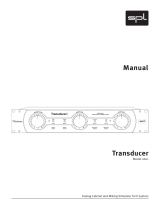
14
Protection circuitry
Last updated: August 9, 2022 05:05. Revision #7622
The EDGE W includes Amplifier Protection Circuitry to detect faults with Over Temperature, DC and Over Current. If any of these faults are detected
the LED standby button will turn red.
Over Temperature
Over temperature is caused by a combination of high listening levels and low impedance speakers. The Edge W includes temperature detection
which constantly monitors the heat generated by the output transistors.
If the monitored temperature reaches a high level (suitably within the limits of the output devices) the amplifier will automatically switch into a fault
mode To protect itself from damage.
If the loudspeaker impedance is low the temperature of the amplifier may rise faster as the amplifier is working harder. If the amplifier is mounted
in a cabinet or the ventilation slots are obstructed the over temperature detection may activate/reactivate after a short listening time.
Remedy - Leave the unit for 15 minutes to cool down before pressing the Standby button to resume normal operation. If the unit has not fully
cooled down then the temperature may reach the limit soon after the amplifier is powered up.
DC
EDGE W offers loudspeaker protection if the output of the amplifier goes to a high constant voltage (DC) because of some internal fault. This is a
rare fault, although detecting it will protect your loudspeakers from damage.
Remedy - Due to the necessary sensitivity of the DC protection circuit, extremely hard clipping of the amplifier may cause DC protection to be
triggered. If this fault occurs, please contact your dealer for service or our support team https://www.cambridgeaudio.com/support-query.
Over Current
EDGE W offers V/I (voltage/current) protection by constantly monitoring the output transistors to keep them working inside their Safe Operating
Area (SOA). The SOA is a set of limits given by the output transistor manufacturer to ensure reliability. The V/I protection has been incorporated
within the amplifier circuitry to provide a fast response to temporary overload conditions. When the V/I protection is triggered the unit will continue
to operate but distortion may be heard as the unit protects the output transistors.
Remedy - Reduce the volume. If distortion is still present, check the speaker connections and impedance ratings.

















